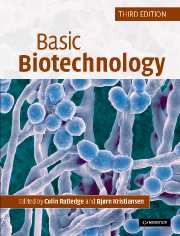Book contents
- Frontmatter
- Contents
- List of contributors
- Preface to the second edition
- Preface to the third edition
- Part I Fundamentals and principles
- Chapter 1 Public perception of biotechnology
- Chapter 2 Biochemistry and physiology of growth and metabolism
- Chapter 3 Stoichiometry and kinetics of microbial growth from a thermodynamic perspective
- Chapter 4 Genome management and analysis: prokaryotes
- Chapter 5 Genetic engineering: yeasts and filamentous fungi
- Chapter 6 Microbial process kinetics
- Chapter 7 Bioreactor design
- Chapter 8 Mass transfer
- Chapter 9 Downstream processing
- Chapter 10 Measurement, monitoring, modelling and control
- Chapter 11 Process economics
- Part II Practical applications
- Index
Chapter 10 - Measurement, monitoring, modelling and control
Published online by Cambridge University Press: 05 June 2012
- Frontmatter
- Contents
- List of contributors
- Preface to the second edition
- Preface to the third edition
- Part I Fundamentals and principles
- Chapter 1 Public perception of biotechnology
- Chapter 2 Biochemistry and physiology of growth and metabolism
- Chapter 3 Stoichiometry and kinetics of microbial growth from a thermodynamic perspective
- Chapter 4 Genome management and analysis: prokaryotes
- Chapter 5 Genetic engineering: yeasts and filamentous fungi
- Chapter 6 Microbial process kinetics
- Chapter 7 Bioreactor design
- Chapter 8 Mass transfer
- Chapter 9 Downstream processing
- Chapter 10 Measurement, monitoring, modelling and control
- Chapter 11 Process economics
- Part II Practical applications
- Index
Summary
Introduction
It is the cellular activities, such as those of enzymes or nucleic acids, that determine the performance of bioprocesses. Unfortunately, they are difficult or impossible to measure on-line. Consequently, we need to monitor or estimate variables such as the concentrations of biomass, metabolites, substrates, products or regulator molecules. These dependent variables often can represent the process objectives more or less directly. If not, models need to be constructed and exploited to link the variables that can be measured or monitored to the desired process objectives. We also need to know all the relevant operating variables that influence the desired objectives significantly and also how they influence them.
Terminology
Measuring means to describe a variable qualitatively and/or quantitatively. The variable can be a physical one, which is usually quite simple to measure, a chemical one or a biological one, which can be quite tricky to measure. It involves an analytical method and instrument(s). Measurements of variables of interest are normally indirect measuring methods. To measure glucose concentration, for example, we convert a known aliquot of β-d-glucose in the presence of (dissolved) oxygen using the enzyme glucose oxidase into gluconolactone and hydrogen peroxide, which we eventually oxidise using an amperometric electrode: the final measure is the electric current that we relate to the glucose concentration by using stoichiometric and kinetic models.
Monitoring means to obtain process information without manual or personnel intervention and without disturbing the process. This includes cases where samples must be withdrawn from the process.
- Type
- Chapter
- Information
- Basic Biotechnology , pp. 251 - 270Publisher: Cambridge University PressPrint publication year: 2006
- 1
- Cited by



